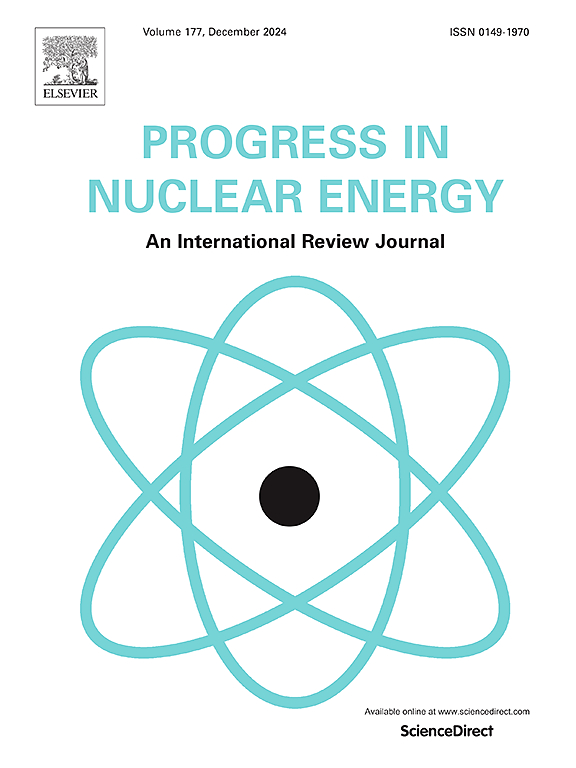Falcon干贮存模型的实现:包层蠕变、包层辐照损伤退火和燃料氦膨胀
IF 3.3
3区 工程技术
Q1 NUCLEAR SCIENCE & TECHNOLOGY
引用次数: 0
摘要
干贮存是核燃料循环的一个重要阶段,因为它可以降低衰变热,从而使用过的燃料可以安全地运输到最终储存库并储存起来。然而,干贮存期长达数十年,在此期间必须保证燃料棒的完整性。燃料性能代码Falcon允许模拟反应堆运行条件下的核棒,但模型没有考虑到具有更大时间尺度和不同热机械环境的干储存条件。在Falcon中引入特定模型对于可靠地模拟干储存中的燃料棒是必要的。因此,在代码中实现了新的包层蠕变、包层退火和燃料氦膨胀模型,并对每个模型进行了验证。对瑞士压水堆代表棒和沸水堆棒进行了基础辐照模拟。已经应用了基准的干储存条件。间隙闭合被认为是熔覆层应力增加的主要原因。在沸水比情况下,不计算间隙闭合,不同模型的包层力学响应差异不大。在压水堆的情况下,计算了间隙闭合,观察到退火模型和包层温度历史对包层环向应力的影响有限。另一方面,燃料氦膨胀模型对计算应力有显著影响。在实际工况下,采用干蓄模型计算得到的压水堆和沸水堆的环向应力分别低于90和70 MPa的临界值。在实际温度条件下,计算得到的环向应变小于1%。本文章由计算机程序翻译,如有差异,请以英文原文为准。
Implementation of dry storage models in Falcon: cladding creep, annealing of cladding irradiation damage, and fuel helium-swelling
Dry storage is an important phase of the nuclear fuel cycle as it allows a reduction in the decay heat so that the used fuel can be safely transported to and stored in a final repository. However, the dry storage period lasts several decades and the integrity of the fuel rods must be guaranteed during this time. The fuel performance code Falcon allows simulating nuclear rods in reactor operating conditions, but the models are not taking into account the dry storage conditions which have a greater time scale and different thermal and mechanical environments. The introduction of specific models in Falcon is necessary for the reliable simulation of fuel rods in dry storage. Therefore, new cladding creep, cladding annealing and fuel helium-swelling models have been implemented in the code and the validation is performed for each model. Base irradiation simulations have been performed for a Swiss PWR representative rod and a BWR rod. Dry storage conditions from a benchmark have been applied. Gap closure is identified as the main contributor to stress increase in the cladding. In the BWR case, no gap closure is calculated and little difference is observed in the cladding mechanical response for different models. In the PWR case, gap closure is calculated and it is observed that the annealing model and cladding temperature history have a limited effect on the cladding hoop stress. On the other hand, the fuel helium-swelling model has a pronounced impact on the calculated stresses. In realistic conditions and with the use of the dry storage models, the calculated hoop stress is below the critical values of 90 and 70 MPa for PWR and BWR, respectively. Also, the calculated Hoop strain is below 1 % in realistic temperature conditions.
求助全文
通过发布文献求助,成功后即可免费获取论文全文。
去求助
来源期刊

Progress in Nuclear Energy
工程技术-核科学技术
CiteScore
5.30
自引率
14.80%
发文量
331
审稿时长
3.5 months
期刊介绍:
Progress in Nuclear Energy is an international review journal covering all aspects of nuclear science and engineering. In keeping with the maturity of nuclear power, articles on safety, siting and environmental problems are encouraged, as are those associated with economics and fuel management. However, basic physics and engineering will remain an important aspect of the editorial policy. Articles published are either of a review nature or present new material in more depth. They are aimed at researchers and technically-oriented managers working in the nuclear energy field.
Please note the following:
1) PNE seeks high quality research papers which are medium to long in length. Short research papers should be submitted to the journal Annals in Nuclear Energy.
2) PNE reserves the right to reject papers which are based solely on routine application of computer codes used to produce reactor designs or explain existing reactor phenomena. Such papers, although worthy, are best left as laboratory reports whereas Progress in Nuclear Energy seeks papers of originality, which are archival in nature, in the fields of mathematical and experimental nuclear technology, including fission, fusion (blanket physics, radiation damage), safety, materials aspects, economics, etc.
3) Review papers, which may occasionally be invited, are particularly sought by the journal in these fields.
 求助内容:
求助内容: 应助结果提醒方式:
应助结果提醒方式:


